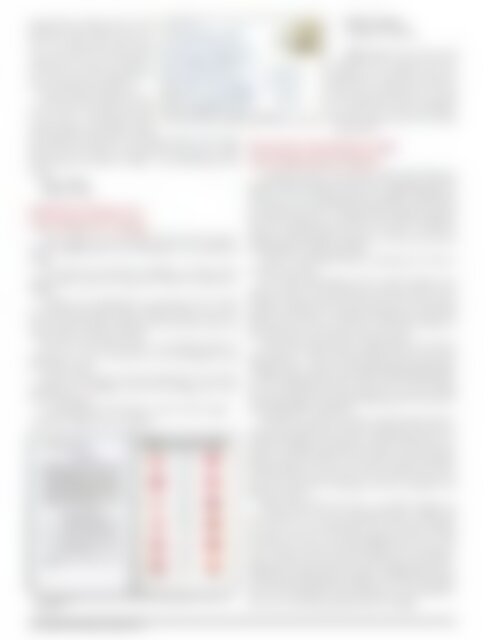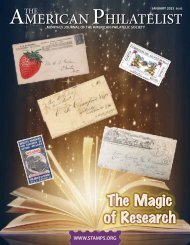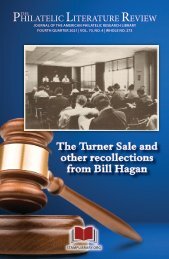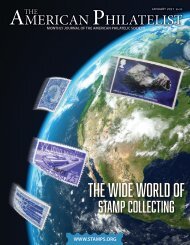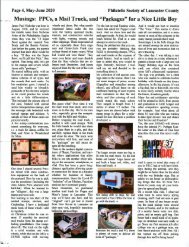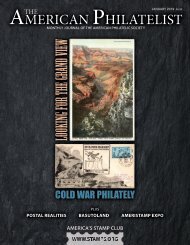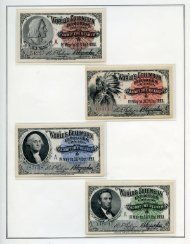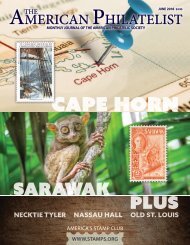August 2018 - Sneak Peek
The American Philatelist is the monthly journal of the American Philatelic Society, the world's largest organization for stamp collectors and enthusiasts. Members receive the printed magazine and can access the digital edition as a benefit of membership in the Society. Please enjoy this sneak peek. We're confident that once you see all that we offer, you'll want to join the APS today.
The American Philatelist is the monthly journal of the American Philatelic Society, the world's largest organization for stamp collectors and enthusiasts. Members receive the printed magazine and can access the digital edition as a benefit of membership in the Society. Please enjoy this sneak peek. We're confident that once you see all that we offer, you'll want to join the APS today.
You also want an ePaper? Increase the reach of your titles
YUMPU automatically turns print PDFs into web optimized ePapers that Google loves.
postal history material since I have<br />
philatelic interest that he does not.<br />
Last year, along with other items,<br />
came a postcard of Sarawak natives<br />
with pets on a canoe in rough terrain.<br />
The postcard is dated July 12,<br />
1964, and the postmark July 13.<br />
Based on what I read in the column<br />
by Noel Davenhill, this seems<br />
to have been a transitional period<br />
when Sarawak had already joined<br />
the Malaysian Federation and British stamps were being<br />
phased out. The stamp on the postcard (Scott 209) – going<br />
from Sarawak to Ontario, Canada – is not illustrated in the<br />
article.<br />
Juan L. Riera<br />
Miami, Florida<br />
Publications Disagree Over<br />
Color Listing for U.S. Stamp<br />
There appears to be a discrepancy between two Scott publications<br />
regarding the correct description of one particular<br />
stamp.<br />
The <strong>2018</strong> Scott Specialized Catalogue of United States<br />
Stamps and Covers lists a variety of U.S. Scott 267 as 267b, vermillion.<br />
Another Scott publication, the Specialized Color Guides<br />
for United States Stamps (2005), indicates “there are no 'reds'<br />
[which would include vermillion] in the 267 group. There are<br />
many shades of carmine and pink.”<br />
The Scott Color Guides covers a very limited number of<br />
stamps, but it covers in detail the 2-cent Washington issues<br />
from 1890 to 1903.<br />
Several months ago I sent this information to the Amos<br />
Publishing Co., publishers of the Scott catalogs, but I have<br />
heard no response.<br />
I would hope that APS sleuths or other readers might …<br />
“confirm or disprove my conclusion.”<br />
An inside page from Scott Color Guides showing the colors for U.S.<br />
Scott 267.<br />
William Manion<br />
Longmont, Colorado<br />
Editor’s note: The editorial staff<br />
reviewed your question and the<br />
publications in question and concur<br />
that there is a discrepancy. The Scott<br />
Color Guides has been out of print<br />
for awhile (the American Philatelic<br />
Research Library’s most recent copy<br />
is from 2005.)<br />
What Stamp Collecting Has at Stake<br />
in the Trump/Amazon Dispute?<br />
President Donald Trump has personally called Postmaster<br />
General Megan Brennan several times complaining that the<br />
Postal Service isn’t charging Amazon enough for shipping. So<br />
far, Brennan has resisted Trump’s demands. She points out that<br />
the postal bureaucracy is charged with codifing regulations<br />
and laws regarding postal rates and contracts. An arbitrary<br />
change can’t and shouldn’t be made to a contract just because<br />
one stakeholder really doesn’t like it.<br />
There are competing narratives regarding why Trump is<br />
focused on Amazon:<br />
The Trump administration has a decent business case<br />
against Amazon. It is a behemoth. It’s driving a heck of a lot of<br />
economic change. [It’s owner, Jeff] Bezos is one of the richest<br />
people in the world. The company probably got a good deal<br />
from the USPS. Some say Amazon is a creative force; others say<br />
it’s just destructive. I leave that to the economists.<br />
On the other hand, there’s a strong business case that the<br />
administration – which, in this particular instance, seems to be<br />
Trump himself – has got it all wrong. Shipping approximately<br />
1.2 billion packages/year via the USPS, Amazon probably does<br />
have an excellent deal with the Postal Service, and it supplies<br />
a huge percentage of the package shipping, the Postal Service’s<br />
most profitable line of business.<br />
Furthermore, Amazon is already experimenting with driverless<br />
trucks and delivery by drones, and doing so increases its<br />
artificial intelligence advantage over USPS and all other competitors.<br />
So, pull the plug on the Post Office, and Amazon has a<br />
parallel model that is all set to go, and the company will likely<br />
dominate delivery systems, just as it has retail ones. Since Amazon<br />
has invented the technology, anti-trust complaints will<br />
likely go nowhere.<br />
Many people believe that this is a political struggle, not<br />
an economic one. It can be, admittedly, hard to separate the<br />
two. Bezos owns The Washington Post, and Trump considers<br />
the paper to be one of the world’s biggest purveyors of “fake<br />
news.” The Post is one of Trump’s harshest critics, asserting, for<br />
instance, that he has lied more than 3,000 times since being inaugurated.<br />
Trump promised to initiate a struggle against Amazon<br />
during the presidential campaign, “If I become president,<br />
they (sic The Washington Post) are gonna have such problems,”<br />
and we are witnessing a significant power struggle.<br />
730 AMERICAN PHILATELIST / AUGUST <strong>2018</strong>


